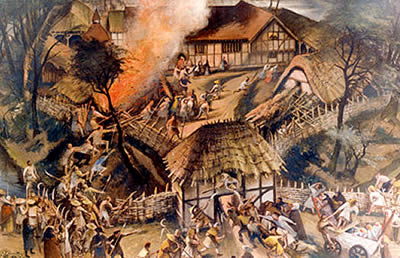 |
| Dissenters in England |
The term dissenters refers to those who officially or unofficially separate themselves from an established or state church. This term is sometimes used interchangeably in the context of early modern English history with Nonconformists.
However, nonconformity is a later development within the larger dissenter movement, usually denoting those who disagreed with the state church in both practice and principle. In England, religious dissenters did not constitute a single discernible movement or aktivitas but a series of protests against the established Church of England during the 16th to 18th centuries.
While the history of religious dissent is as old as Christianity itself, dissent in England can certainly be traced to the time of John Wycliffe and the sect known as the lollards. Wycliffe was a 14th century English university professor whose greatest contribution was his translation of the Scriptures into the English vernacular. He believed that the Bible was the supreme authority for religious matters, that the clergy should not own property, and that the Catholic understanding of transubstantiation had no basis in Scripture.
 |
While his ideas were condemned by the Catholic Church, the later, more radical sect of the lollards adopted some of his views and continued on until the time of the English reformations in the 16th century, consequently setting the stage for later religious dissents.
English dissenters began to appear once again during the time of the Protestant Reformation in England under Edward VI, Elizabeth I, the Stuart kings, and during and after the time of the interregnum of the English Civil War. Many of these had hoped for a purer reformation of religion in England and expressed their dissatisfaction with the efforts of the English monarchy to continue to control the established state church.
During the reign of Elizabeth I, many of her Protestant advisers had also hoped for a reformation in England similar to the continental reformations. They desired a total break with the vestiges of the more liturgical and episcopal structures, which they felt were entirely consistent with the medieval Catholicism from which they had separated.
During this period, dissenters and Nonconformists began to refer to the group now commonly known as Puritans. Many of these English Puritans disliked both the structure of the episcopacy and an established state church. They began to separate themselves from the Church of England and have their own private meetings.
While Elizabeth I would attempt to get her clergy to conform, many of these dissenters would continue to spread their ideas about church government and worship, attracting more followers. In 1620, a group of these dissenters would sail to America on the May-flower and settle in New England in attempt to find religious freedom in the New World. Consequently, they transplanted their own religious dissent to America profoundly shaping both early American religion and national identify in the process.
During the time of the English Civil War (1642–51) and the interregnum (1649–60), the dissenters seized power and abolished the Church of England. They began to practice iconoclasm, destroying churches and stained glass and imprisoning many of the Anglican bishops.
Parliament was now the head of the Church of England and it quickly instituted a more presbyterian form of church government. The Westminster Assembly now became the sole and permanent committee dedicated to the reform of the English Church.
In May of 1660, Charles II was restored to the throne of England from exile in France. He made attempts to ensure some sort of religious toleration with his Declaration of Indulgence. However, the now mostly Anglican Parliament had forced him to withdraw this measure. Instead they passed what is known as the Clarendon code, which established Anglicanism as the true state religion of England and made overt threats toward any that might not conform.
The Test Act of 1673 required all persons in civil or military offices to subscribe to the oaths of supremacy and allegiance and to affirm that they did not believe in the doctrine of transubstantiation. Furthermore, they had to receive the sacrament of the Anglican Church within three months after admittance to office.
Eventually, in 1689, Parliament passed the Toleration Act, which allowed the English people to practice whatever religion they desired so long as they were trinitarian Protestants. This act however did not suspend any of their civil disabilities that went along with their dissenting religion.
The Test Act, which was expanded in 1678, was not suspended until 1828. In 1829, Parliament passed the Roman Catholic Relief Act, which began to give freedom to Roman Catholics to practice their religion freely for the first time since before the Reformation.
Consequently, many of the dissenters in English religious history survive in present-day Christian denominations. Many of these are now known as “Free Churches.” Some of these are Baptists, Presbyterians, Congregationalists, Methodists, Quakers, and Moravians.
EmoticonEmoticon